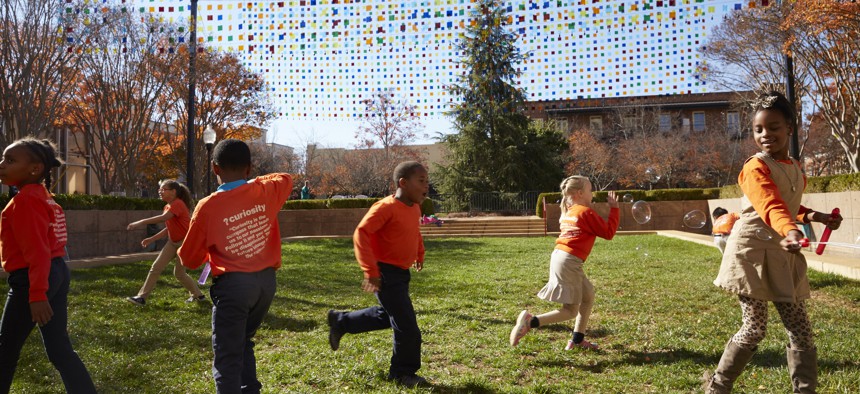Investments in the Arts Strengthen Local Economies and Communities

Children play under Mobile Suspension, by artist Erwin Redl, part of the city of Spartanburg’s public art project, “Seeing Spartanburg in a New Light.” Bloomberg Philanthropies
Kate Levin, head of Bloomberg Philanthropies’ Arts Initiatives, explains why civic art is about more than simple beauty.
Editor’s note: Bloomberg Philanthropies has issued its second Public Arts Challenge to cities. The challenge will offer three cities up to $1 million each over two years “temporary public art projects that celebrate creativity, enhance urban identity, encourage public-private collaborations, and strengthen local economies.” Applications are due by April 19.
NEW YORK — Having spent nearly 20 years working in or on behalf of government, including 12 years as commissioner of New York City’s Department of Cultural Affairs, I know that economic development is often a key mayoral priority. And the focus in this area is usually on commercial projects.
While the arts may not always seem to be an obvious area for investment, the sector has uniquely comprehensive impact. Cultural activity creates social cohesion, builds neighborhood identity, supports local economies by providing direct and ancillary jobs for residents, and generates spending at a range of businesses, large and small—from equipment suppliers and caterers to parking garages, dry cleaners and babysitters.
The collective impact of these local benefits is captured in a recent national study by the U.S. Bureau of Economic Analysis and the National Endowment for the Arts. According to this study, arts and culture industries:
- Contributed $763.6 billion to the U.S. economy in 2015, outpacing the agricultural sector, transportation, and warehousing industries.
- Employed 4.9 million workers, who earned $372 billion in total compensation.
- Saw a $20 billion trade surplus.
- Had an average growth rate of 2.6 percent between 2012 and 2015, slightly higher than 2.4 percent for the nation’s overall economy.
Moreover, the arts are key to attracting and retaining a talented workforce.
The trend we’re seeing across the nation is that people want to live in culturally vibrant cities. They want to go to festivals, check out art galleries, listen to live music, eat great food and meet interesting people. It’s a main reason why, according to a study by City Observatory, the number of college educated people age 25 to 34 living within three miles of city centers is up 37 percent since 2000, even as the total population of these neighborhoods has slightly shrunk.
At Bloomberg Philanthropies, we work to support mayoral efforts to create strong cities by spearheading initiatives in five focus areas: arts, education, environment, government innovation, and public health. I oversee our Arts Program, where we aim to help mayors promote culturally and economically vibrant cities where people want to live and work. We draw on our decades of experience working with artists and cultural organizations to develop targeted initiatives that bolster the creative infrastructure in cities around the world.
One of the ways that Bloomberg Philanthropies helps mayors advance civic priorities, enhance cultural vibrancy and strengthen local economies is by supporting public art projects.
In our experience, public art projects can create the kind of opportunities that are often central to most mayors’ civic agendas. They bring residents together around a sense of place, raise aware about pressing issues, foster new partners and collaborations and catalyze economic investments and spending.

For instance, The Gates by Christo and Jeanne-Claude generated $254 million for New York City during its 16-day installation in 2005. Light City, an art and music festival featuring over 20 light installations in Baltimore’s inner harbor, spurred $44 million in economic impact for the city last year. And Lumiere London, a four-day long citywide public art festival in London, produced £21.8 million in audience spending, with retail income increasing by 28 percent in select neighborhoods in 2016.
Based on our extensive history supporting public art projects globally and our strong belief that these kinds of projects can bolster vibrancy and economic opportunities, we launched the Public Art Challenge in 2014. This initiative invites U.S. cities to apply for up to $1 million in funding for a temporary public art project that addresses local challenges.
Our inaugural Public Art Challenge supported four projects in six U.S. cities: ArtHouse: A Social Kitchen in Gary, Indiana; Breathing Lights in Albany, Schenectady and Troy in New York; CURRENT:LA Water in Los Angeles; and Seeing Spartanburg in a New Light in Spartanburg, South Carolina. In addition to encouraging community building, collaboration, and conversation about important civic issues, the four projects catalyzed $13 million for local economies and employed 820 people.
Inspired by the success of our inaugural program, Bloomberg Philanthropies recently announced a call for submissions for a second iteration of the Public Art Challenge.
Once again, we are inviting all eligible U.S. mayors to partner with their local creative sector on developing a proposal for an ambitious temporary public art project that addresses a pressing issue. Applications are due on April 19, and more information about the initiative and how to apply can be found at publicartchallenge.bloomberg.org.
As we gear up for this next round, we’re excited to learn about the innovative ideas percolating in cities across the nation and look forward to sharing the most promising projects with you in the months to come.
Kate Levin is head of Bloomberg Philanthropies Arts program and a principal at Bloomberg Associates in Cultural Assets Management.
NEXT STORY: Route Fifty Turns 3 Years Old





